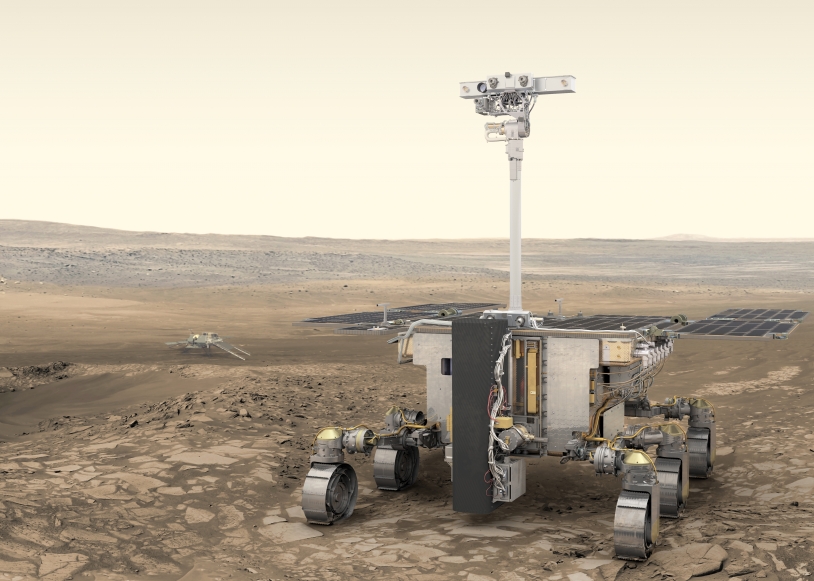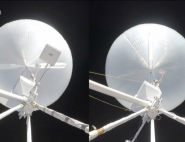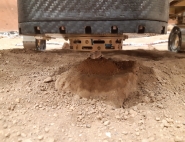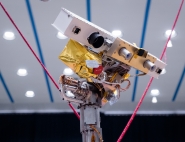Rosalind Franklin rover

Artist’s impression of the Rosalind Franklin rover on Mars. Credits: ESA/ATG Medialab.
The Rosalind Franklin rover will deploy its mast and solar panels shortly after landing and then egress from the Kazachok surface platform. The rover’s six driving wheels are designed to overcome obstacles of a few tens of centimetres. Each wheel has its own electric motor and deformable metal treads with cleats for extra grip. The design of the rover chassis also gives it a ‘walking’ capability that will be useful if it gets stuck in sandy soil. The mission plans to operate the rover for 180 days, powered by its solar panels. It will be tele-operated from Earth but with an autonomous navigation capability and is expected to cover a distance of 100 metres a day on average.
The 310-kilogram rover will begin its science mission in 2021. It will characterize its environment and then collect samples from places selected with the aid of the data relayed back to Earth. Its instruments will determine the mineral composition of the samples and look for organic molecules.
Rover Instruments
Rosalind Franklin will carry the Pasteur payload, comprising a suite of 9 instruments.
Panoramic instruments: The panoramic camera (PanCam), equipped with colour filters, will acquire imagery of the terrain around the rover to select locations to visit and map routes to reach them. High-resolution cameras will provide textural detail on rocks or outcrops selected by the science team on Earth. The Infrared Spectrometer for ExoMars (ISEM) will provide a first indication of their mineral composition. The WISDOM radar (Water Ice and Subsurface Deposit Observation on Mars) will probe the subsurface down to about 5 metres to identify sediment layers and detect buried rocks. This information will serve to determine drilling depths and locations, complementing those collected by ADRON, which detects hydrogen in the shallow subsurface. Hydrogen in the soil on Mars indicates the presence of water molecules and hydrated minerals.
Contact instruments: The drill, capable of collecting samples down to a depth of 2 metres, has an infrared spectrometer called Ma_MISS (Mars Multispectral Imager for Subsurface Studies) housed inside its tip. It obtains rock cores about 1 cm in diameter and 2 cm long, which it then transfers for crushing and delivery to the analytical instruments. The CLUPI camera (Close-Up Imager) will acquire high-resolution images of drill locations, fines and core samples.
Rock core samples will be crushed and delivered to the Analytical Laboratory Drawer (ALD).
Analytical instruments: The surface of crushed samples will first be analysed by MicrOmega, an infrared and visible microscope able to identify minerals and detect organic molecules. Zones deemed to be of most interest will then be analysed with the Raman Laser Spectrometer (RLS), which will complement the mineralogy data and specify the composition of any organic matter detected. If the sample appears scientifically interesting, a small portion will be delivered to MOMA (Mars Organic Molecule Analyser), which comprises three complementary instruments.
A mass spectrometer will identify ions and organic molecules from LIBS (Laser-Induced Breakdown Spectroscopy) or from the gas chromatograph. LIBS uses its laser to generate ions that are then delivered to the mass spectrometer. Before routing to the gas chromatograph, a few milligrams of crushed samples are first heated in a system of small ovens, where a chemical solvent may be added if necessary. Any organic matter vaporized by the heat is delivered to the gas chromatograph and then to the mass spectrometer, which determines the mass and partial composition.
The MicrOmega and WISDOM instruments are each being developed by a French research laboratory. Other French laboratories are making significant contributions to the MOMA, RLS and CLUPI instruments.
| Instrument | Description | Principal investigators | |
| PanCam - Panoramic Camera | Panoramic camera to perform digital terrain mapping of Mars. | PI: Andrew John Coates, MSSL/University College London, London, United Kingdom Co-PI (High Resolution Camera): Ralf Jaumann, DLR/IPF, Berlin, Germany Co-PI (Wide Angle Cameras): Jean-Luc Josset, Institute for Space Exploration, Neuchâtel, Switzerland. | |
| ISEM - Infrared Spectrometer for ExoMars | Infrared spectrometer to assess the mineralogical composition of surface targets. Working with PanCam, ISEM will contribute to the selection of suitable samples for further analysis by the other instruments. | Oleg Korablev, Space Research Institute (IKI), Moscow, Russia | |
| CLUPI - Close - UP Imager | A camera system to acquire high-resolution colour close-up images of rocks, outcrops, drill fines and drill core samples. | PI: Jean-Luc Josset, Space Exploration Institute, Neuchâtel, Switzerland Co-PI: Frances Westall, Centre de Biophysique Moléculaire, Orléans, France Co-PI: Beda Hofmann, Natural History Museum, Berne, Switzerland. | |
| WISDOM - Water Ice and Subsurface Deposit Observation On Mars | A ground-penetrating radar to detect sediment layers under the rover. WISDOM will be used with ADRON, which can provide information on subsurface water content, to decide where to collect subsurface samples for analysis. | PI: Valérie Ciarletti, LATMOS, France Co-PI: Svein-Erik Hamran, FFI, Norway Co-PI: Dirk Plettemeier, TU-Dresden, Germany. | |
| Adron | To search for subsurface hydrogen in water and hydrated minerals. ADRON will be used in combination with WISDOM to study the subsurface beneath the rover and to search for suitable areas for drilling and sample collection. | PI: Igor Mitrofanov, Space Research Institute (IKI), Moscow, Russia. | |
| Ma_MISS - Mars Multispectral Imager for Subsurface Studies | A multispectral imager inside the drill tip that will contribute to the study of Martian mineralogy and rock formation. | PI: Maria Cristina De Sanctis, Istituto di Astrofisica Spaziale e Fisica Cosmica (IASF), INAF, Italy. | |
| MicrOmega | A visible and infrared imaging spectrometer designed to detect organic matter in samples and identify their mineral composition at grain scale. | PI: Jean-Pierre Bibring, Institut d’Astrophysique Spatiale, Orsay, France Co-PI: Frances Westall, Centre de Biophysique Moléculaire, Orléans, France Co-PI: Nicolas Thomas, University of Berne, Switzerland. | |
| RLS - Raman Spectrometer | Raman laser spectrometer to establish mineralogical composition and identify organic pigments. | PI: Fernando Rull Perez, Centro de Astrobiología, Unidad Asociada (CSIC-UVA), Spain Co-PI: Sylvestre Maurice, Laboratoire d'Astrophysique - Observatoire Midi-Pyrénées (LAOMP), France. | |
| MOMA – Mars Organic Molecule Analyser | MOMA will target biomarkers or biosignatures in samples. | PI: Fred Goesmann, Max-Planck-Institute for Solar System Research, Lindau, Germany Co-PI: Francois Raulin, University of Paris 12 and 7, Paris, France. | |


